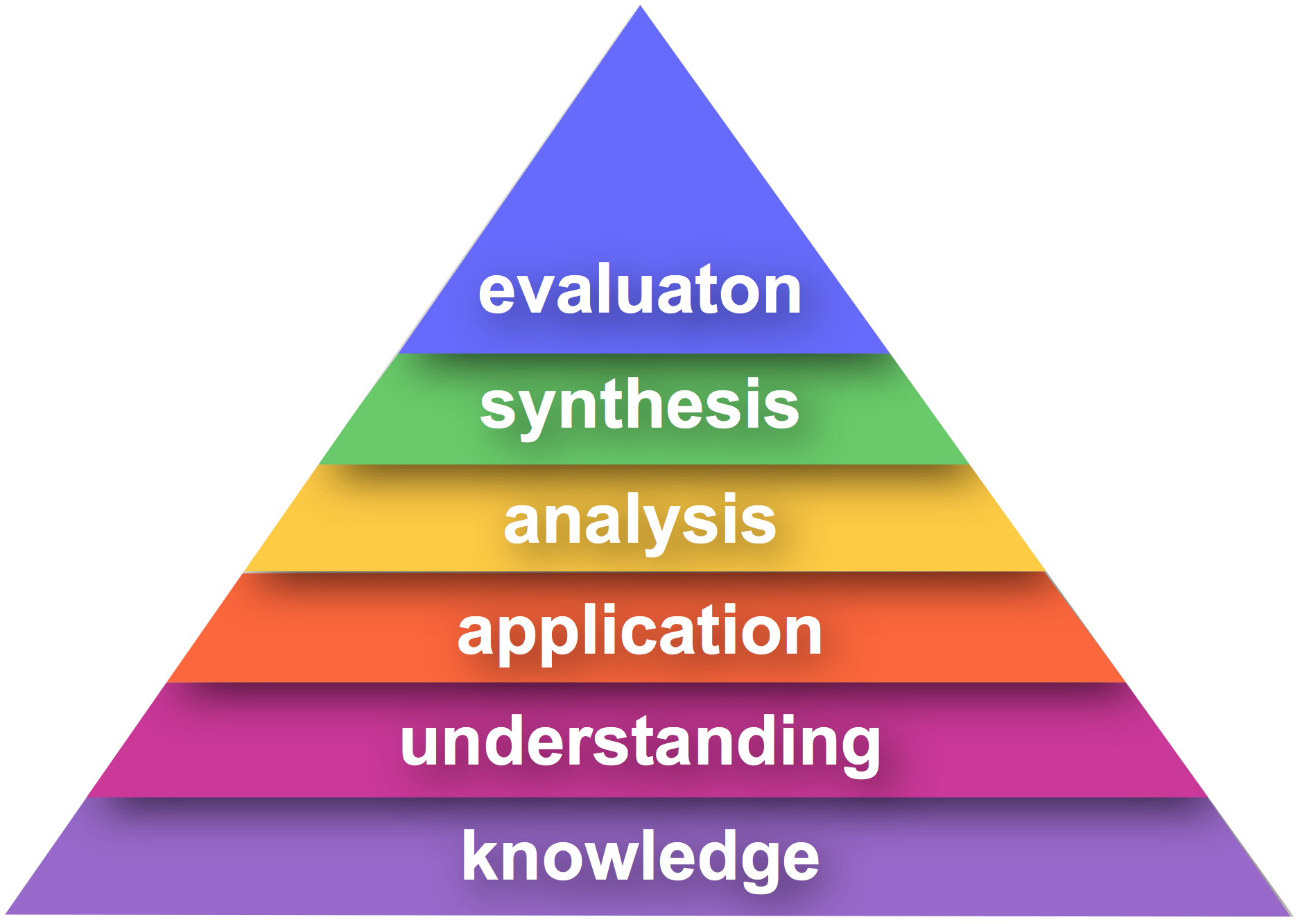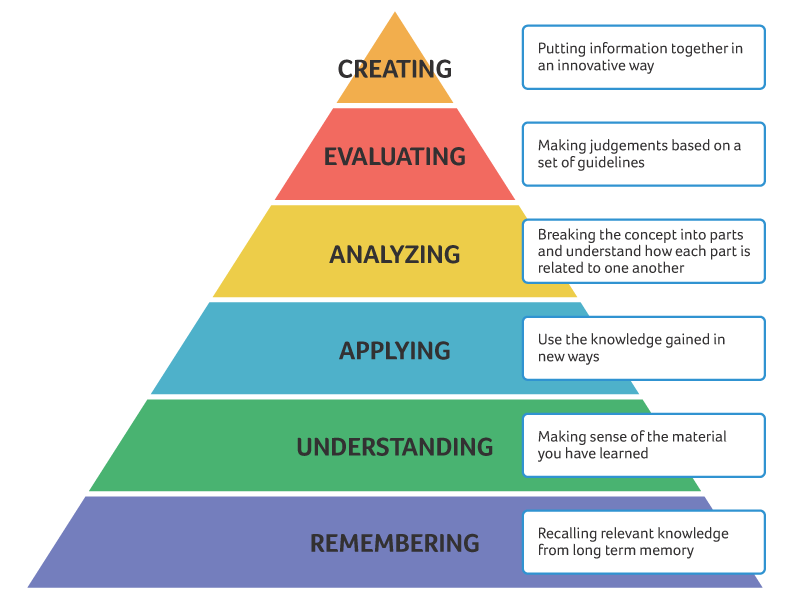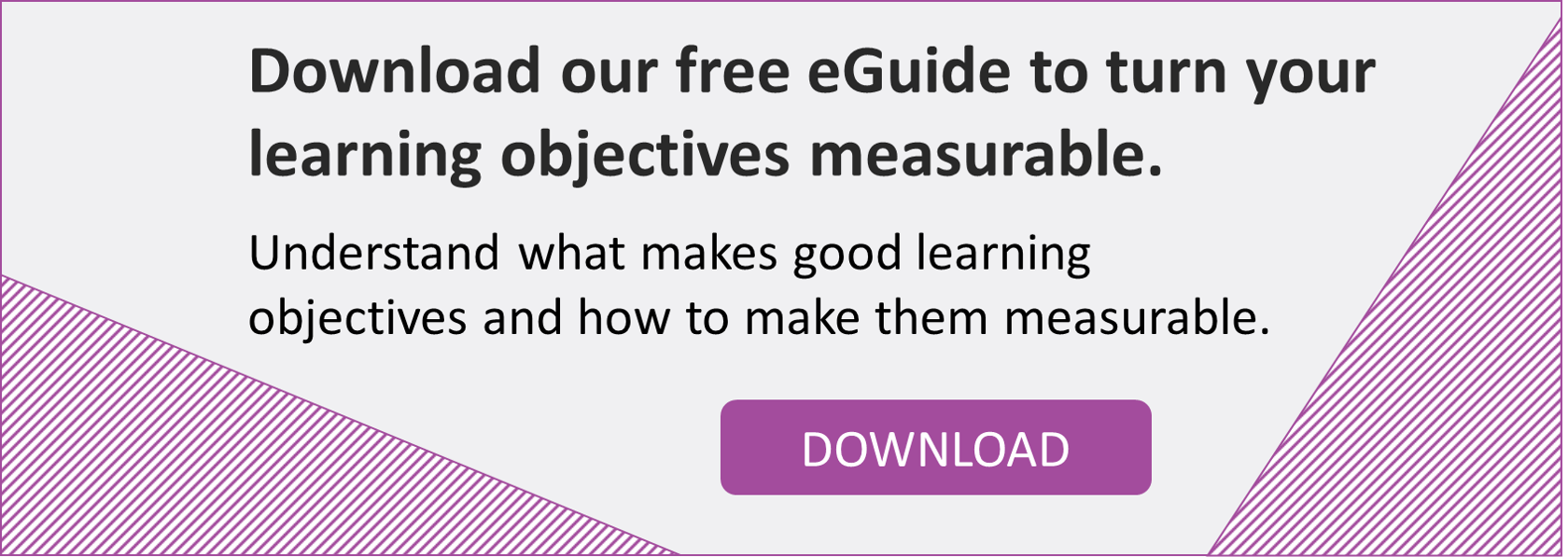
If you've read our ultimate guide to understanding Bloom's taxonomy, you may want to find out more about Bloom's levels of learning. This post will explain everything you need to know about these levels and help you develop a full understanding of what they are, how they help and how they can be used to improve the learning process.
This post will explain:
-
What Bloom’s taxonomy levels of learning are
-
The three key domains; affective, cognitive and psychomotor
-
How to apply Bloom’s taxonomy levels of learning when designing a course
-
How to use Bloom’s taxonomy level of learning to assess and evaluate learning.
Contents
-
An introduction to Bloom’s taxonomy
-
The Original Bloom’s taxonomy 6 levels of learning
-
The Revised Bloom’s taxonomy 6 levels of learning
-
Types of knowledge in the revised Bloom’s taxonomy
-
How to use Bloom’s 6 levels of learning
-
Examples of how to apply each level of learning
-
Further reading
1. An introduction to Bloom’s taxonomy
In 1956, Benjamin Bloom and his team of collaborators published their book, Taxonomy of Educational Objectives. Their framework soon became known as Bloom’s Taxonomy and provides a way of categorizing educational goals. It went on to enjoy widespread popularity among generations of teachers and instructors and has been applied across a broad range of age groups, from kindergarten to college level. both at a K-12 school level and at a college level.
Bloom’s taxonomy helps teachers and instructors create curricula, course, lesson plans, and learning activities, as well as formative and summative assessments. It helps ensure that the students have clear measurable goals and expectations.
2. The Original Bloom’s taxonomy 6 levels of learning
The original taxonomy featured six major categories of thinking.
There were:
-
Knowledge
-
Comprehension
-
Application
-
Analysis
-
Synthesis
-
Evaluation
As a taxonomy, Bloom’s framework has to be followed in order; learners must start at the first stage – Knowledge – and master that level before moving on to the next. The first level – Knowledge – is a necessary precondition for the following five levels. For this reason, the taxonomy is often presented as a pyramid to show that knowledge acts as a foundation for all subsequent levels of learning:

The five areas of learning above Knowledge are known as ‘skills and abilities’. Each category contains various subcategories, ranging from simple tasks to complex tasks.
A brief explanation of each category
The following explanations are derived from the 1984 edition of Bloom’s Handbook One.
Knowledge
This initial level involved recalling basic facts, processes, and methods, or patterns and structures.
Comprehension
This level refers to the learners’ understanding of the ideas and materials presented at the first level. At this stage, they won’t necessarily be able to see the full implications or their knowledge or be able to relate it to other material.
Application
At this level of thinking, learners should be able to use their knowledge and understanding in certain situations.
Analysis
At the analysis level, learners are expected to be able to articulate the relationship between different ideas and be able to breakdown their learning into elements or parts.
Synthesis
This level of thinking involves combining different ideas or elements to create new structures or ideas.
Evaluation
In the original Bloom’s taxonomy, ‘evaluation’ was the highest level of thinking and was thought to require the most complex mental processes. At this level, learners are expected to make judgments about the value of the methods or materials presented to them.
3. The Revised Bloom’s Taxonomy 6 levels of learning
A group of researchers, psychologists, and assessment specialists produced a revised version of Bloom’s Taxonomy, A Taxonomy for Teaching, Learning, and Assessment, in 2001. Their main goal was to move the focus away from purely educational objectives and make it clearer for learners to understand specifically what was required of them at each stage.
In place of static objectives and nouns used in the original Bloom’s taxonomy, the revised version uses verbs and gerunds to describe the cognitive processes that students and learners are required to use.
These are:
-
Remember
-
Understand
-
Apply
-
Analyze
-
Evaluate
-
Create
In common with Bloom’s original work, learners must still approach a topic or subject from the lowest level – Remember – and master that before moving on to higher levels of thinking.

A brief explanation of each category
The revised Bloom’s taxonomy categories are briefly explained below.
Remember
Action verbs such as ‘recognizing’, and ‘recalling’ tell the learner that the learning is at the lowest level of thinking.
Understand
Work at this level is likely to require actions such as ‘interpreting’, ‘exemplifying’, ‘classifying’, ‘summarizing’, ‘inferring’, ‘comparing’ and ‘explaining’.
Apply
If learners are asked to ‘implement’ or ‘execute’ a task or action, they would likely be working at this level of thinking.
Analyze
At the analytical stage, learners are commonly asked to ‘differentiate’, ‘organize’ or ‘attribute’ facts, data or subject matter.
Evaluate
Learners working at this high level of thinking may be asked to ‘critique’ or ‘check’ materials.
Create
In the revised Bloom’s taxonomy, creating something original or substantially new is considered to be the highest level of thinking. Verbs such as ‘generate’, ‘plan’ or ‘produce’ tell learners that they are required to work at this level.
4. Types of knowledge in the revised Bloom’s taxonomy
In addition to the six cognitive processes, the authors of the revised taxonomy created a separate taxonomy for four distinct types of knowledge.
These are:
Factual Knowledge
Learners need to demonstrate knowledge of specific details, elements or terminology.
Conceptual Knowledge
Learners need knowledge of theories, models, principles, classifications, and categories.
Procedural Knowledge
Learners need to know specific techniques, skills, algorithms or methods.
Metacognitive Knowledge
Learners need self-knowledge about cognitive tasks and contextual knowledge.
5. How to use Bloom’s 6 levels of learning
At this point, you may be wondering, “Why use Bloom’s taxonomy?’
Here’s the deal:
Bloom’s taxonomy is incredibly flexible and can be used in conjunction with most teaching philosophies and teaching styles. Its popularity stems from the fact that it is highly adaptability and versatile, making is well suited to a number of different tasks.
These are:
-
Course or curriculum planning
-
Setting learning goals or objectives
-
Creating learning activities
-
Creating assessments or evaluations
Let’s look at each of these areas separately.
Course or curriculum planning
Bloom’s taxonomy helps educators plan a curriculum, syllabus or course by offering a structure about how people learn. The lowest levels of learning – Remembering and Understanding – must feature near the start of the course or curriculum. Instructors must ensure that learners have a good grasp of the content at these levels before moving on to higher levels of learning such as applying, evaluating or creating.
Setting learning goals or objectives
Objectives or learning goals are crucially important if the teacher is to establish a pedagogical interchange with their students. Clear goals will help the learners understand the purpose of the learning. They help the instructor plan and deliver instruction at an appropriate level. Bloom’s taxonomy helps to ensure that the right learning goals are set, according to the level of learning that the learners are engaged.
Creating learning activities
Bloom’s taxonomy helps educators create appropriate learning activities for the level of learning that is taking place. For example, on a course focused at the lower levels of learning, an activity that involves analysis or creation may be unsuitable. Bloom’s taxonomy helps instructions set the activities at the right level.
Creating assessments or evaluations
Lastly, Bloom’s taxonomy helps educators set assessments and evaluations at the right level. Worthwhile assessments will reflect the level of thinking that has been taking place.
6. Examples of how to apply each level of learning
If you want to put Bloom’s taxonomy into practice, here are some examples of the ways you might apply each level of learning.
Level 1: Remembering
This is the most basic level of Bloom’s taxonomy but is a necessary prerequisite for the following stages.
If you are teaching at this level, you may use verbs such as:
- Recall
- outline
- describe
- identify
- list
- label
This will help you to measure the learner’s success in this stage. The purpose is to ensure that students memorize facts but doesn’t guarantee that they actually understand the material.
Sample Level 1 learning activities
You may ask the learners to recite something you’ve taught them or ask them to quote information from previous classes, lectures or notes. Alternatives include multiple choice questions, or simple question and answer sessions.
Level 2: Understanding
The second level of learning in Bloom’s taxonomy is when a learner can comprehend or interpret the materials presented during classes or lecture.
At this level, you may use verbs like:
- paraphrase
- explain
- retell
- generalize
- summarize
Sample Level 2 Learning Activities
Your options include asking learners to provide analogies of a given topic or concept, telling a story, explaining a concept in their own words, or paraphrasing something they have learned.
Level 3: Applying
This level of thinking asks learners to use and apply the material or skills that they have been studying.
You may use verbs like
- use
- solve
- show
- predict
- apply
- demonstrate
The goal is to measure whether students can make use of their learning.
Sample Level 3 Learning Activities
The range of learning activities at this level varies enormously. If the learning focuses on practical skills such as making phone calls or completing a form, the assessment would mirror that real-life activity. If the focus is on knowledge, such as a math formula, you might ask learners to make a calculation that demonstrates their understanding of the formula.
Level 4: Analyzing
Analyzing is the upper-half of the levels of learning in Bloom’s taxonomy. The goal is to assess whether students can draw connections between ideas and utilize their critical thinking skills.
Verbs you may use include:
- Infer
- deconstruct
- differentiate
- compare
- analyze
Sample level 4 learning activities
You may ask students to find fallacies in the reasoning of various arguments or use logical deduction to determine how a particular piece of equipment works. These tasks allow the students to demonstrate that they can understand the material fully, and can break it down into its component parts.
Level 5: Evaluating
At the second-highest level of learning of Bloom’s taxonomy, you are assessing whether students can differentiate between facts, opinions, and inferences.
Verbs you may use include:
- critique
- evaluate
- appraise
- conclude
Sample Level 5 Learning Activities
You may ask learners to justify a specific decision or find an effective solution to a problem while backing up that decision with a justification. Blogs and surveys are popular learning activities at this level.
Level 6: Creating
The highest level of learning in Bloom’s taxonomy is asking the learner to create something either tangible or conceptual.
You may use verbs such as:
- write
- generate
- design
- combine
- devise
- modify.
Sample Level 6 Learning activities
If the learning is practical in nature, you may ask learners to design a product or physical device such as a piece of machinery. If the learning is conceptual or intangible, a suitable learning activity may be writing a report, creating a manual, writing an essay or paper.

7. Problems with using Bloom’s taxonomy
As with any theoretical construct, Bloom’s taxonomy is open to interpretation and doesn’t have to be precisely followed or applied to every given situation. For instance, when designing a course, it may not be necessary to have the learners start at the lowest level – remembering – and work their way up.
The solution?
If you are creating a bespoke course or syllabus for a group of learners, you can use formative assessments to gauge learners’ abilities before you start designing. This will help you set appropriate learning goals and pitch the instruction at the right level.
Creativity doesn’t have to be the end goal, either. You can use creativity as a tool to spark inspiration and learning. In a corporate learning environment, for example, you could ask the participants to create their own solution to a problem. This could act as an engaging and inspiring entry event, as you could deconstruct the solution and use it as a creative way of introducing facts, knowledge and basic concepts around a subject.
8. Further reading
To discover more about Bloom’s taxonomy and how to use it to improve the effectiveness of your training evaluation, consider getting in touch with us below.
Related posts:
